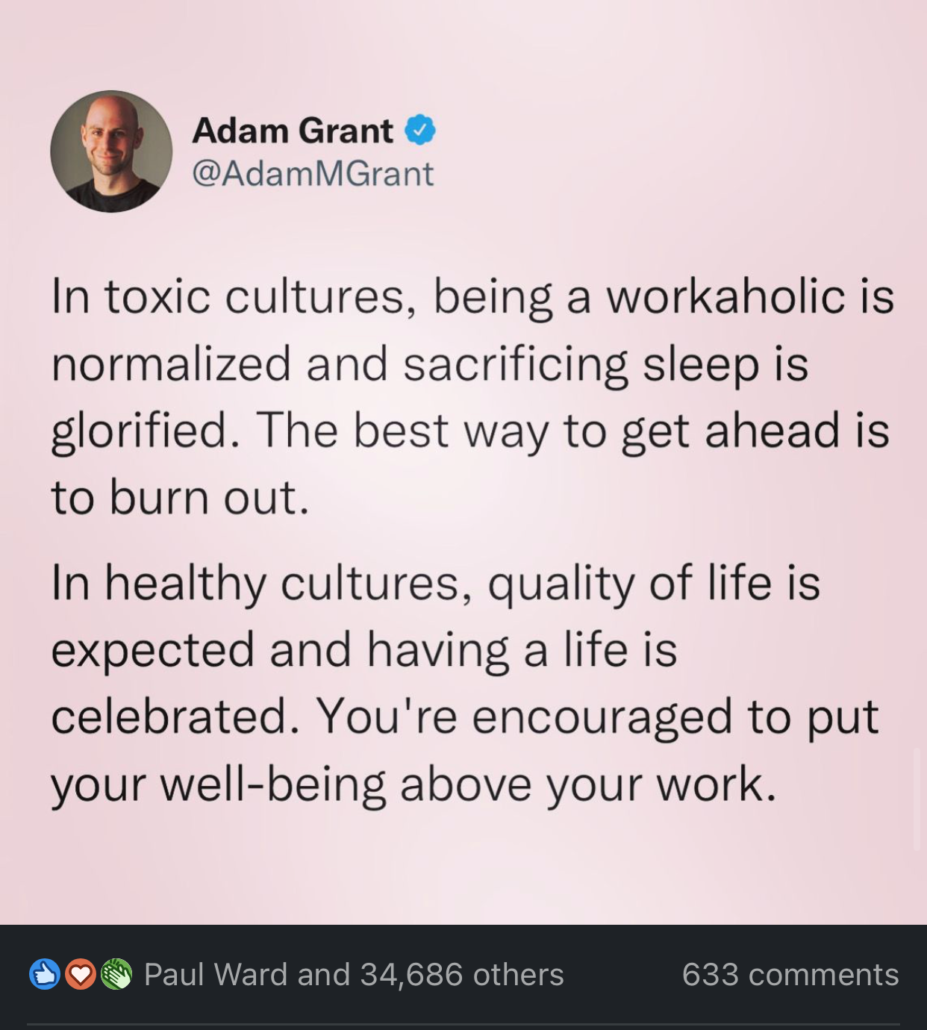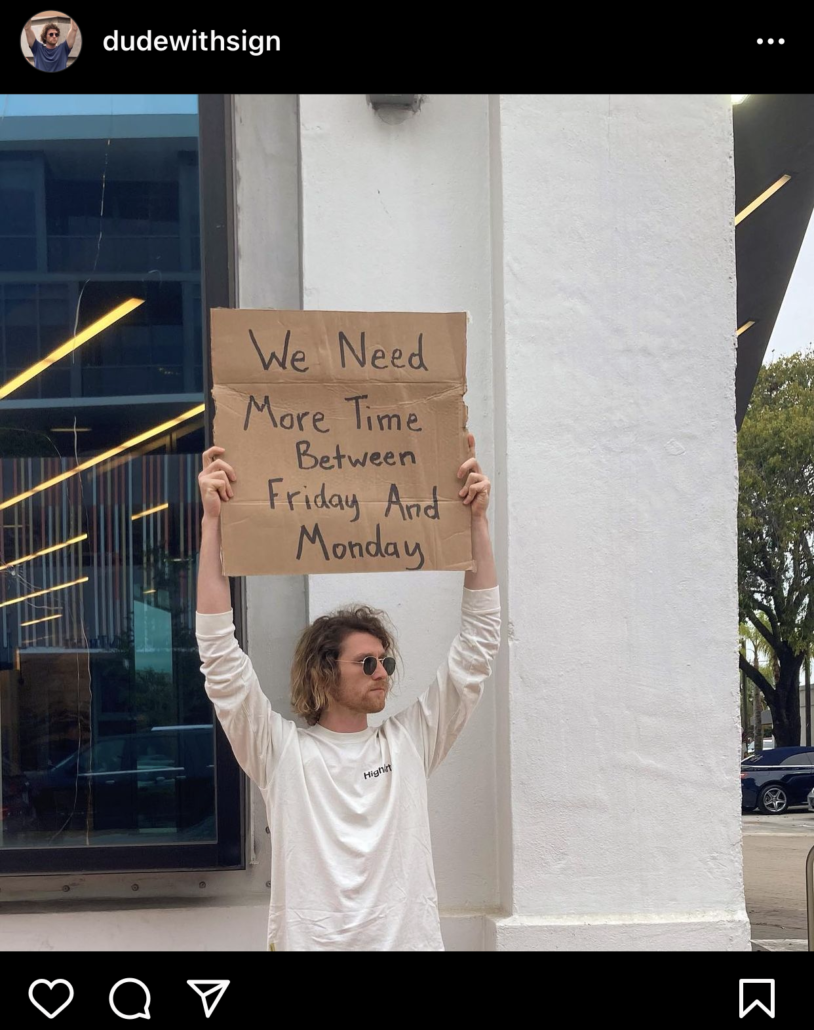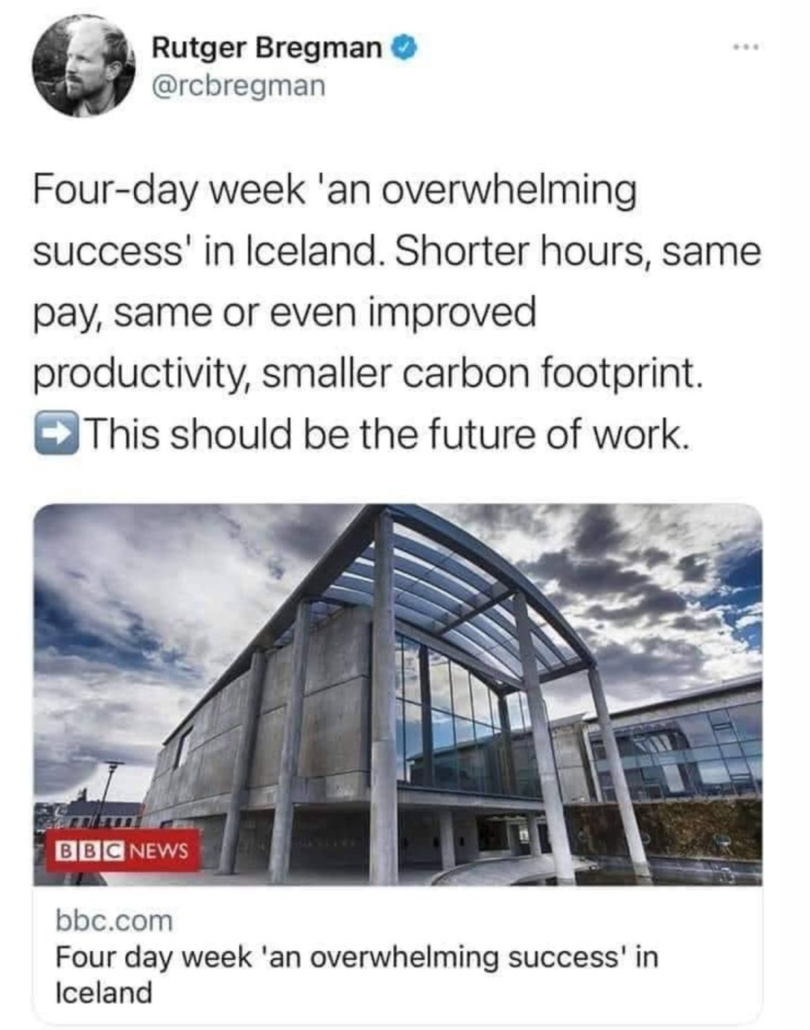
Let me let you in on a secret. I have always been incredibly jealous of people who have a short work week. You know the nurse who “works four tens.” Or the tech bro who works four days a week at home in his robe and slippers. Or the dentist who closes down shop one day a week. You know the people I’m talking about.
The thing about those people is that they never seem to fully appreciate their good fortune. In conversation, they might casually drop the fact that they only work four days a week. Like it’s no big deal. “Doesn’t everyone have a three-day weekend?” Every. Week. Of. Their. Lives?
No, most of us grind through five, six, or even seven days of work a week. And it’s barbaric.

But changes are afoot. The pandemic has changed everything. Employees are tired and are quitting in record numbers, citing burnout and under-appreciation as primary factors. Naturally, many employers are looking at alternatives.
Enter the four-day workweek.

But first, a very brief primer on the five-day workweek.
the battle for a five-day workweek.
Beginning with the Industrial Revolution (roughly 1760-1840), workers in the United States started working a large number of hours per week. It was common for factory workers to work 70, 80, or 90 or more hours per week.
In 1866, the newly-formed National Labor Union, tried to get Congress to pass a law mandating an eight-hour worked day. The effort failed, but launched a national movement for an eight-hour workday.
In 1890 the United States started tracking worker hours. It found that manufacturing employees were averaging 100 hours per week. Let that sink in, 100 hours per week.
In 1869, President Ulysses S. Grant issued a proclamation guaranteeing an eight-hour workday and stable wages for government workers.
In the private sector, organized labor and employers spent the next sixty years fighting the issue. Every year on May Day, labor organizations across the country organized strikes and demonstrations to bring attention to the eight-hour workday. Sometimes the protests turned violent.
Finally, in 1906, two major printing companies instituted the eight-hour workday.
In 1916, ten years later, Congress passed the Adamson Act, establishing an eight-hour workday for interstate railroad workers. And in 1926, the Ford Motor Company instituted a five-day, forty-hour workweek.
On June 25, 1938, Congress passed the Fair Labor Standards Act. It originally limited the workweek to 44 hours. In 1938, Congress amended the Act to limit the workweek to 40 hours.
Thank God. Well, kind of.

john maynard keynes was wrong, but i like where his head was at.
Famed economist, John Maynard Keynes, predicted that improving technology and increasing efficiency would deliver a 15-hour workweek by 2030. I think we can safely say that Keynes was wrong.
But not entirely. Maybe technology, efficiency, and changing attitudes can deliver a 32-hour workweek by 2022?
In the wake of the pandemic, a number of businesses are reevaluating how they do business, including how much they work. A number are moving to a four-day workweek. They do so based on the rationale that the four-day workweek boosts productivity, increases employee satisfaction, and potentially lowers operating costs.
Below is a very small sampling of private and public sector employers experimenting with the four-day workweek.
- Shake Shack. In 2018, the fast food chained reduced managers’ workweeks in some locations to 32 per hours a week without cutting pay. They noticed a spike in recruitment. In 2020, Shake Shack expanded the new schedule to one-third of its 164 locations across the country. Recently, Shake Shack unveiled a plan to invest $9 million in wage increase for current employees.
- Kickstarter. The crowdfunding platform recently announced plans to experiment with a four-day workweek. Kickstarter is one of the most prominent companies to implement the schedule. It is doing so based on academic backed research from the Four Days a Week campaign. Among other things, the campaign seeks to enlist more employers to experiment with the four-day schedule to obtain more data on its effectiveness.
- Basecamp. The project management software company gives its employees a four-day workweek from May through August each year. Employees are eligible for the summer schedule after working at Basecamp for one year.
- Wildbit. The software company, inspired by Basecamp, implemented a four-day workweek. It did so in attempt to improve productivity and the quality of life of its employees. Wildbit’s CEO, Natalie Nagele, argues that shift calls for fundamentally different approach to work that is largely antithetical to the traditional corporate approach.
- Reykjavík. The Nordic island of Iceland tested the four-day workweek between 2015 and 2019 with approximately 1% of its working population. It found that productivity was stable or a little higher. In response, it is reported that approximately 86% of Iceland’s workforce have either moved to shorter hours for the same pay, or will gain the right to adopt the four-day workweek.
- United Kingdom. More recently, the United Kingdom announced that it is launching a six-month trial of the four-day workweek. Under the trial, employees will receive 100% of their pay for four days of work per week. Identical trials are reported to be taking place across Ireland, Canada, Australia, and New Zealand.

add a utah law firm to the list.
Starting earlier this year, our small personal injury firm joined the experiment. We are working four-day workweeks for the same pay. The directive is simple. Let’s see if we can get as much work done, and make as much money, as we normally do, but work less. If we can succeed, we will keep doing it. If not, we will go back to the five-day workweek.
I have a sneaking suspicion, we are all going to work harder and smarter to avoid that outcome. The risk is too great. Our new lifestyles too wonderful to fail.

To contact Shane about your Salt Lake City personal injury case, call or text 385-429-9960 or e-mail s@godsis.lawyer.
Salt Lake personal injury lawyer, Salt Lake personal injury attorney, Provo personal injury attorney, Provo personal injury lawyer, Orem personal injury attorney, Orem personal injury lawyer, West Valley personal injury lawyer, West Valley personal injury attorney, West Jordan personal injury attorney, West Jordan personal injury lawyer, South Jordan personal injury attorney, South Jordan personal injury lawyer, South Salt Lake personal injury attorney, South Salt Lake personal injury lawyer, Bountiful personal injury attorney, Bountiful personal injury lawyer, Magna personal injury attorney, Magna personal injury lawyer, Murray personal injury attorney, Murray personal injury lawyer, Midvale personal injury attorney, Midvale personal injury lawyer, Sandy Utah personal injury attorney, Sandy Utah personal injury lawyer, Lehi Utah personal injury attorney, Lehi Utah personal injury lawyer, Utah County personal injury attorney, Utah County personal injury lawyer, St. George Utah personal injury attorney, St. George Utah personal injury lawyer, Ogden personal injury attorney, Ogden personal injury lawyer, Kearns Utah personal injury attorney, Kearns Utah personal injury lawyer, Layton Utah personal injury attorney, Layton Utah personal injury lawyer, Millcreek Utah personal injury attorney, Millcreek Utah personal injury lawyer, Holladay Utah personal injury lawyer, Holladay Utah personal injury attorney


